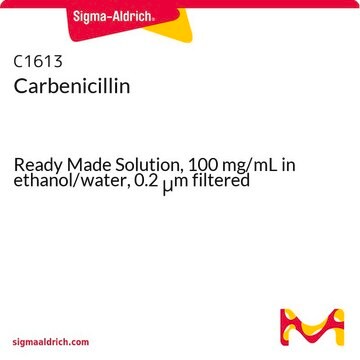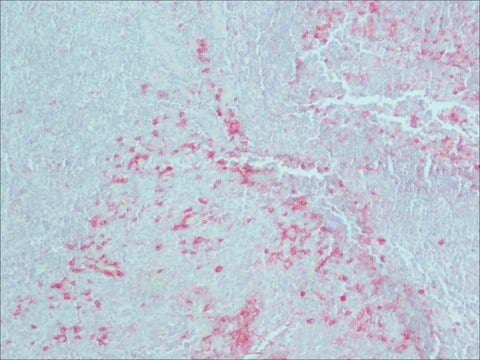C1389
Carbenicillin disodium salt
89.0-100.5% anhydrous basis
Sinónimos:
Carbenicillin, Disodium carbenicillin, α-Carboxybenzylpenicillin disodium salt
About This Item
Productos recomendados
origen biológico
synthetic (chemical)
Nivel de calidad
Análisis
89.0-100.5% anhydrous basis
formulario
powder
color
white to off-white
solubilidad
H2O: 50 mg/mL
espectro de actividad antibiótica
Gram-negative bacteria
Gram-positive bacteria
Modo de acción
cell wall synthesis | interferes
temp. de almacenamiento
2-8°C
cadena SMILES
[Na+].[Na+].CC1(C)S[C@@H]2[C@H](NC(=O)C(C([O-])=O)c3ccccc3)C(=O)N2[C@H]1C([O-])=O
InChI
1S/C17H18N2O6S.2Na/c1-17(2)11(16(24)25)19-13(21)10(14(19)26-17)18-12(20)9(15(22)23)8-6-4-3-5-7-8;;/h3-7,9-11,14H,1-2H3,(H,18,20)(H,22,23)(H,24,25);;/q;2*+1/p-2/t9?,10-,11+,14-;;/m1../s1
Clave InChI
RTYJTGSCYUUYAL-YCAHSCEMSA-L
¿Está buscando productos similares? Visita Guía de comparación de productos
Categorías relacionadas
Descripción general
Carbenicillin is commonly used in cell biology applications to prevent the growth of bacterial contaminants. It is also used in microbiology to select for bacteria that have been transformed with a vector harboring the gene encoding beta-lactamase, which makes them resistant to carbenicillin.
Aplicación
- in the preparation of Luria-Bertani (LB) agar plates and media
- as a selective agent in the culture media to prevent the growth of bacterial contaminants
- in a study focused on the development of monoclonal antibodies
Acciones bioquímicas o fisiológicas
Antimicrobial spectrum: Active against Gram-positive and Gram-negative bacteria
Características y beneficios
- Broad-spectrum antibiotic with bactericidal and beta-lactamase resistant activity
- Effective against a wide range of bacteria, including Pseudomonas aeruginosa
- Commonly used in Cell Biology and Biochemical applications
- Offers greater stablility than ampicillin
Almacenamiento y estabilidad
Nota de análisis
Otras notas
producto comparable
Palabra de señalización
Danger
Frases de peligro
Consejos de prudencia
Clasificaciones de peligro
Resp. Sens. 1 - Skin Sens. 1
Código de clase de almacenamiento
11 - Combustible Solids
Clase de riesgo para el agua (WGK)
WGK 2
Punto de inflamabilidad (°F)
Not applicable
Punto de inflamabilidad (°C)
Not applicable
Equipo de protección personal
dust mask type N95 (US), Eyeshields, Faceshields, Gloves
Choose from one of the most recent versions:
Certificados de análisis (COA)
Don't see the Right Version?
If you require a particular version, you can look up a specific certificate by the Lot or Batch number.
¿Ya tiene este producto?
Encuentre la documentación para los productos que ha comprado recientemente en la Biblioteca de documentos.
Los clientes también vieron
Nuestro equipo de científicos tiene experiencia en todas las áreas de investigación: Ciencias de la vida, Ciencia de los materiales, Síntesis química, Cromatografía, Analítica y muchas otras.
Póngase en contacto con el Servicio técnico










